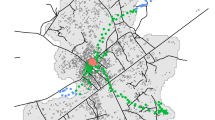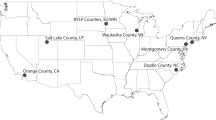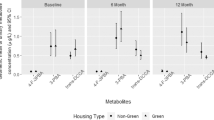Abstract
This pilot study enrolled 20 children between the ages of 11 and 17 months in Imperial County, California to assess children's pesticide exposure and residential proximity to agricultural fields. We compared parental self-report of residential proximity to agricultural fields to measurements using global positioning system/geographical information system (GPS/GIS) technology, and we assessed the relationship between residential proximity to agricultural fields and a biomarker of organophosphate (OP) pesticide exposure. Questionnaires were administered twice, 4 weeks apart, to determine self-reported residential proximity to agricultural fields. Urine samples were collected at each contact to measure OP metabolites. Actual residential proximity to the closest agricultural field and number of fields was within 1 mile to the west were measured using GPS/GIS. Self-report of living proximity to agricultural fields agreed with GPS/GIS measurement 75% of the time during the initial interview, compared to 66% agreement during the second interview. Presence of urinary metabolites suggests that OP exposure was ubiquitous: creatinine-adjusted total urinary dimethyl values ranged from 1.60 to 516.00 μg/g creatinine, and total diethyl ranged from 2.70 to 134.84 μg/g creatinine. No association was found between urinary OP metabolites and residential to field proximity. These results suggest that initial self-report of living proximity to agricultural fields may be more accurate than follow-up self-report. Limitations in this pilot study prevent determination of whether self-report is an accurate measure of proximity.
This is a preview of subscription content, access via your institution
Access options
Subscribe to this journal
Receive 6 print issues and online access
$259.00 per year
only $43.17 per issue
Buy this article
- Purchase on Springer Link
- Instant access to full article PDF
Prices may be subject to local taxes which are calculated during checkout
Similar content being viewed by others
References
Acquavella, J, Burns, C, Flaherty, D et al. A critique of the world resources institute's report “pesticides and the immune system: the public health risks” 1998) 106: 51–54
Allen, BP . Shadows as sources of cues for distance of shadow-casting objects, Percept Mot Skills (1999) 89: 571–584
Ames, R, Howd, RA, Doherty, L . Community exposure to a paraquat drift, Arch Environ Health (1993) 48: 47–52
Annual Pesticide Use Report. Imperial County. Department of Pesticide Regulation, California Environmental Protection Agency 2000
Bravo, R, Driskell, WJ, Whitehead, RD, Needham, LL, Barr, DB . Quantification of dialkyl phosphate metabolites of organophosphate pesticides in human urine using GC-MS/MS with isotopic internal standards, J Anal Toxicol (2002) 26: 245–252
Camann, DE, Geno, PW, Harding, HJ . A pilot study of pesticides in indoor air in relation to agricultural applications, Proceedings of the Sixth International Conference, Indoor Air, Helsinki, Finland (July 4–8, 1993) 2: 207–212
Chester, G, Ward, RJ . Occupational exposure and drift hazard during aerial application of paraquat to cotton, Environ Contam Toxicol (1984) 13: 551–563
Cyass, JB, Lake, JR . Spray drift from a tractor-powered field sprayer, Pestic Sci (1977) 8: 117–126
EPA Publication #730-K95-001Citizen's guide to pest control and pesticide safety. Office of Pesticide Programs, U.S. Environmental Protection Agency, Washington, D.C Sept. 1995
Flipo, D, Bernier, J, Girard, D et al. Combined effects of selected insecticides on humoral immune response in mice, Int J Immunopharmacol (1992) 14: 747–752
Frost, KR, Ware, GW . Pesticide drift from aerial and ground applications, Agric Eng (1970) 51: 460–467
Gempler's English/Spanish translation of USEPA, Protect yourself from pesticides — guide for agricultural workers. Stock #HW20. Gempler's Inc., Bellue, WI Jan. 1994
Hermanowitz, A, Kossman, S . Neutrophil function and infectious disease in workers occupationally exposed to phosphoorganic pesticides: role of mononuclear-derived chemotactic factor for neutrophils, Clin Immunol Immunopathol (1984) 33: 13–22
Imperial California's ValleySullivan Publications, Inc., Riverside, CA 1997
Lewis, RG . Human exposure to pesticides used in and around the household. In: Baker S.R., Wilkinson C.F. (Eds.)The effect of pesticides on human health. Princeton Scientific Publishing, Princeton, NJ 1989
Lewis, RG, Fortmann, RC, Camann, DE . Evaluation of methods for monitoring the potential exposure of small children to pesticides in the residential environment, Arch Environ Contam Toxicol (1994) 26: 1–10
Loewenherz, C, Fenske, R, Simcox, N et al. Biological monitoring of organophosphorus pesticide exposure among children of agricultural workers in central Washington state, Environ Health Perspect (1997) 105: 1334–1353
National Research Council. Pesticide Residues. InPesticides in the diets of infants and children. National Academy Press, Washington, D.C 1993 254–257
Rodgers, K . The immunotoxicity of pesticides in rodents, Hum Exp Toxicol (1995) 14: 111–113
Reigart, JR, Roberts, JR . OP insecticides. InRecognition and management of pesticide poisonings5th editionOffice of pesticide program US EPA 1999 34–47
Simcox, N, Fenske, R, Wolz, S et al. Pesticides in household dust and soil: exposure pathways for children of agricultural families, Environ Health Perspect (1995) 103: 1126–1134
Sinai, MJ, Ooi, TL, He, ZJ . Terrain influences the accurate judgement of distance, Nature (1998) 395: 497–500
Thomas, PT, House, RV . Pesticide-induced modulations of the immune system. In: Ragsdale N.N., Manzer R.E. (Eds.)Carcinogenicity and pesticides. Principles, issues and relationships. American Chemical, Washington, D.C 1989 94–106
Thrasher, JD, Madison, R, Broughton, A . Immunologic abnormalities in humans exposed to chlorpyrifos: preliminary observations, Arch Environ Health (1993) 48: 89–93
Woodward, M . Epidemiology: study design and data analysis. Chapman & Hall/CRC, Boca Raton 1999
Acknowledgements
The authors thank Richard Kwok, a doctoral candidate at the University of North Carolina at Chapel Hill, for GPS/GIS consultation; James Ellis of the Pediatric Medical Group, El Centro, CA for his contributions to study design and community access; Larry Needham of the National Center for Environmental Health, Centers for Disease Control and Prevention, Atlanta, Georgia for analytic collaboration in urinary analysis and interpretation; and the staff of the County of Imperial Public Health Services for support in study implementation. Grant info: Parts of this study were conducted with support from Westat, Inc. (contract 68-D-98-115). Urinary OP metabolite analysis was performed under IAGDW 75938440. Institutional review board approval: IRB approval from the University of North Carolina School of Medicine was obtained. Approval number: 99-EPA-97.
Author information
Authors and Affiliations
Corresponding author
Additional information
The views expressed in this article are those of the individual authors and do not necessarily reflect the views and policies of the U.S. Environmental Protection Agency. Mention of trade names or commercial products does not constitute endorsement or recommendation for use.
Rights and permissions
About this article
Cite this article
ROYSTER, M., HILBORN, E., BARR, D. et al. A pilot study of global positioning system/geographical information system measurement of residential proximity to agricultural fields and urinary organophosphate metabolite concentrations in toddlers. J Expo Sci Environ Epidemiol 12, 433–440 (2002). https://doi.org/10.1038/sj.jea.7500247
Received:
Published:
Issue Date:
DOI: https://doi.org/10.1038/sj.jea.7500247
Keywords
This article is cited by
-
Assessment of residential environmental exposure to pesticides from agricultural fields in the Netherlands
Journal of Exposure Science & Environmental Epidemiology (2018)
-
Sustainable pesticide governance in Bangladesh: socio-economic and legal status interlinking environment, occupational health and food safety
Environment Systems and Decisions (2017)
-
An evaluation of metrics for assessing maternal exposure to agricultural pesticides
Journal of Exposure Science & Environmental Epidemiology (2014)
-
Urine-sampling methods for environmental chemicals in infants and young children
Journal of Exposure Science & Environmental Epidemiology (2009)
-
Using satellite derived land cover information for a multi-temporal study of self-reported recall of proximity to farmland
Journal of Exposure Science & Environmental Epidemiology (2008)



